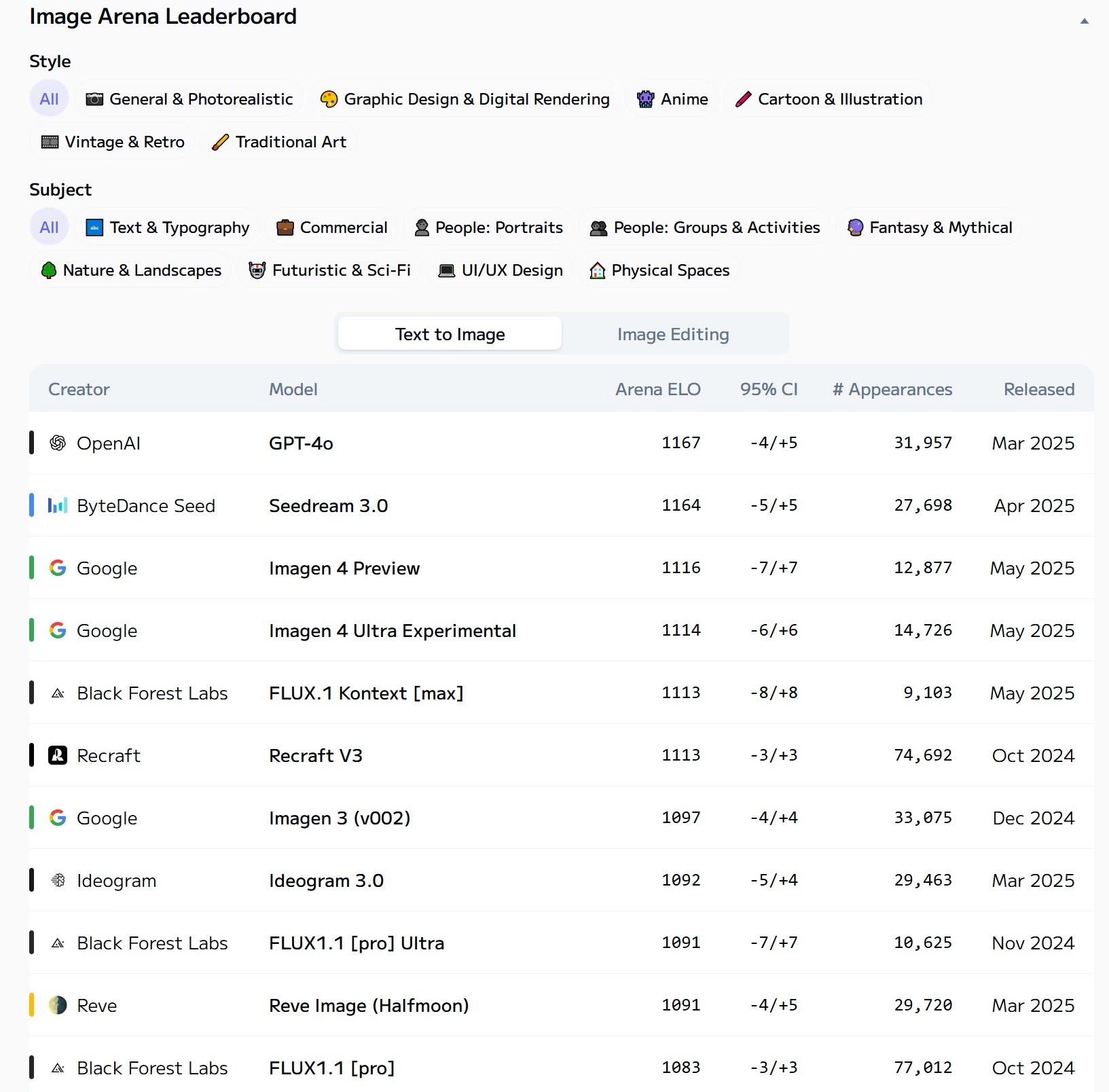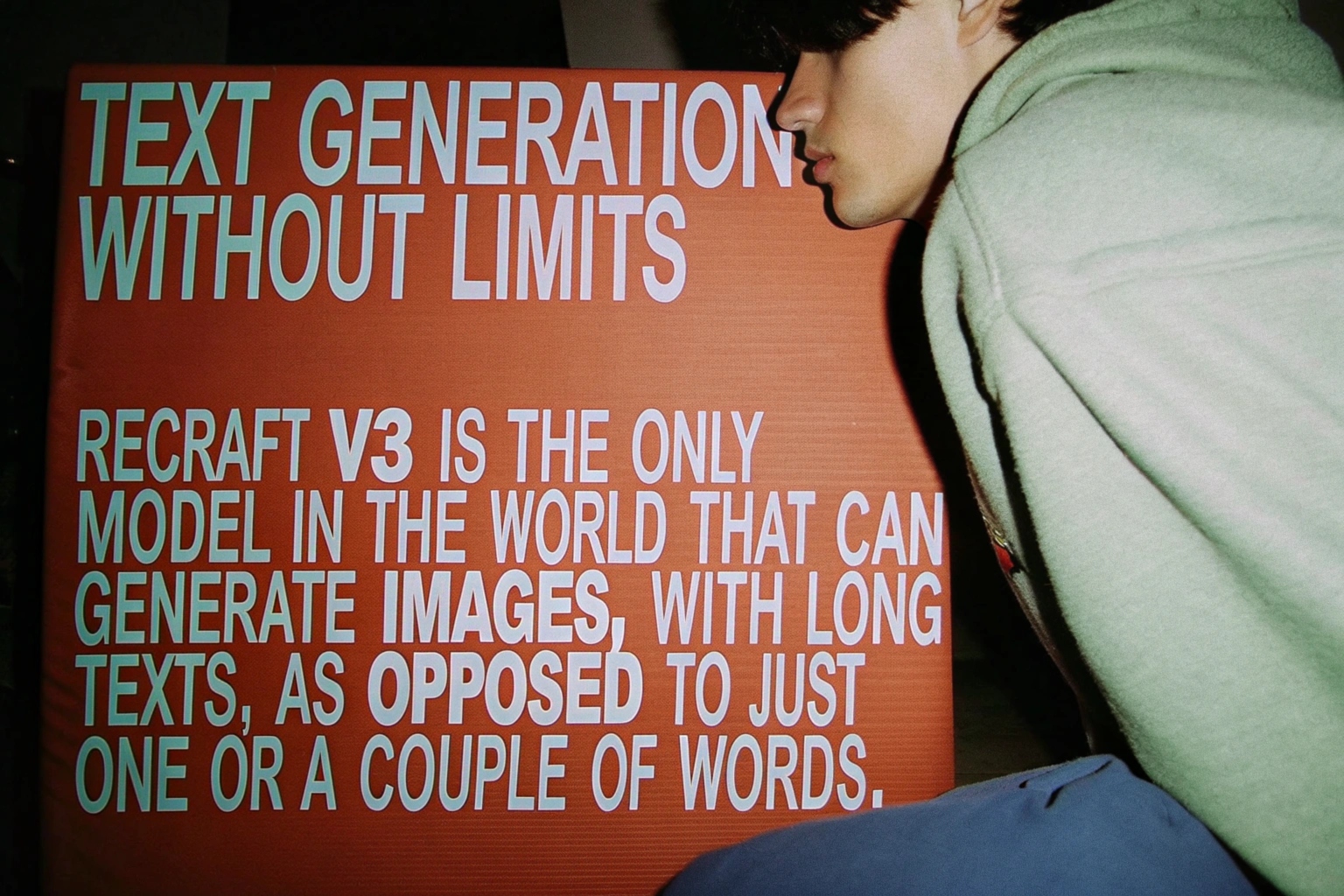BREAKING NEWS
LATEST POSTS
-
Agentic n8n Bigfoot VLOG – Meet my ALIEN friend ZORP
▶︎ You send your idea (from WhatsApp, Telegram, or Slack or manual click)
▶︎ The AI agent (powered by Gemini or any LLM) turns it into a structured video prompt
▶︎ It calls Replicate or Fal.ai to generate the video
▶︎ The final video is saved to your Google Sheet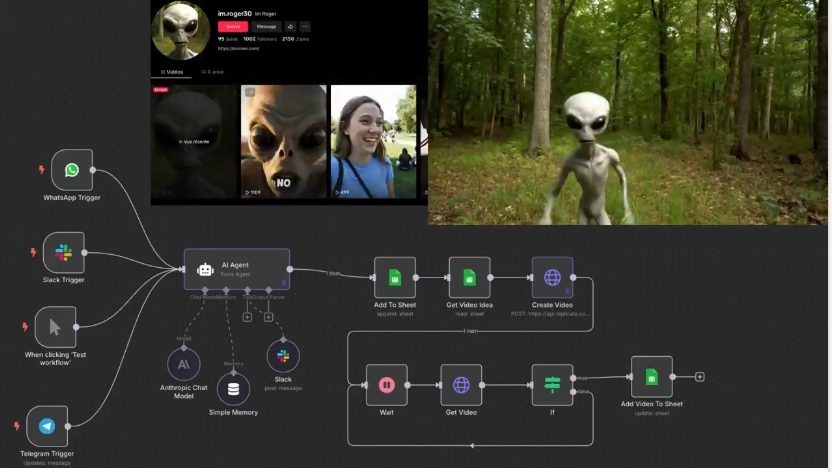
-
Feed Your OWN Documents to a Local Large Language Model AI engine
RAG (retrieval augmented generation)
-
FEATURED POSTS
-
Colour – MacBeth Chart Checker Detection
github.com/colour-science/colour-checker-detection
A Python package implementing various colour checker detection algorithms and related utilities.

-
copypastecharacter.com – alphabets, special characters, alt codes and symbols library
https://www.copypastecharacter.com
https://www.freecodecamp.org/news/alt-codes-special-characters-keyboard-symbols-windows-list/
Most used ones:
Alt + 0149 • bullet point
Alt + 0153 ™ trademark symbol
Alt + 0169 © copyright symbol
Alt + 0174 ® registered trademark symbol
Alt + 0176 ° degree symbol
Alt + 0177 ± plus-or-minus sign
Alt + 0215 × multiplication sign
Alt + 12 ♀ female sign
Alt + 11 ♂ male sign
Alt + 13 ♪ eighth note
Alt + 14 ♫ beamed eighth note
Alt + 251 √ square root check mark
Alt + 8236 ∞ infinity
Alt + 24 ↑ up arrow
Alt + 25 ↓ down arrow
Alt + 26 → right arrow
Alt + 27 ← left arrow
Alt + 29 ↔ left right arrow
Alt + 94 ^All of them:
૱ ꠸ ┯ ┰ ┱ ┲ ❗ ► ◄ Ă ă 0 1 2 3 4 5 6 7 8 9 Ǖ ǖ Ꞁ ¤ Ð ¢ ℥ Ω ℧ K ℶ ℷ ℸ ⅇ ⅊ ⚌ ⚍ ⚎ ⚏ ⚭ ⚮ ⌀ ⏑ ⏒ ⏓ ⏔ ⏕ ⏖ ⏗ ⏘ ⏙ ⏠ ⏡ ⏦ ᶀ ᶁ ᶂ ᶃ ᶄ ᶆ ᶇ ᶈ ᶉ ᶊ ᶋ ᶌ ᶍ ᶎ ᶏ ᶐ ᶑ ᶒ ᶓ ᶔ ᶕ ᶖ ᶗ ᶘ ᶙ ᶚ ᶸ ᵯ ᵰ ᵴ ᵶ ᵹ ᵼ ᵽ ᵾ ᵿ ⁁ ⁊ ⸜ ⸝ ¶ ¥ £ ⅕ ⅙ ⅛ ⅔ ⅖ ⅗ ⅘ ⅜ ⅚ ⅐ ⅝ ↉ ⅓ ⅑ ⅒ ⅞ ← ↑ → ↓ ↔ ↕ ↖ ↗ ↘ ↙ ↚ ↛ ↜ ↝ ↞ ↟ ↠ ↡ ↢ ↣ ↤ ↥ ↦ ↧ ↨ ↩ ↪ ↫ ↬ ↭ ↮ ↯ ↰ ↱ ↲ ↳ ↴ ↵ ↶ ↷ ↸ ↹ ↺ ↻ ↼ ↽ ↾ ↿ ⇀ ⇁ ⇂ ⇃ ⇄ ⇅ ⇆ ⇇ ⇈ ⇉ ⇊ ⇋ ⇌ ⇍ ⇎ ⇏ ⇐ ⇑ ⇒ ⇓ ⇔ ⇕ ⇖ ⇗ ⇘ ⇙ ⇚ ⇛ ⇜ ⇝ ⇞ ⇟ ⇠ ⇡ ⇢ ⇣ ⇤ ⇥ ⇦ ⇨ ⇩ ⇪ ⇧ ⇫ ⇬ ⇭ ⇮ ⇯ ⇰ ⇱ ⇲ ⇳ ⇴ ⇵ ⇶ ⇷ ⇸ ⇹ ⇺ ⇻ ⇼ ⇽ ⇾ ⇿ ⟰ ⟱ ⟲ ⟳ ⟴ ⟵ ⟶ ⟷ ⟸ ⟹ ⟺ ⟻ ⟼ ⟽ ⟾ ⟿ ⤀ ⤁ ⤂ ⤃ ⤄ ⤅ ⤆ ⤇ ⤈ ⤉ ⤊ ⤋ ⤌ ⤍ ⤎ ⤏ ⤐ ⤑ ⤒ ⤓ ⤔ ⤕ ⤖ ⤗ ⤘ ⤙ ⤚ ⤛ ⤜ ⤝ ⤞ ⤟ ⤠ ⤡ ⤢ ⤣ ⤤ ⤥ ⤦ ⤧ ⤨ ⤩ ⤪ ⤫ ⤬ ⤭ ⤮ ⤯ ⤰ ⤱ ⤲ ⤳ ⤴ ⤵ ⤶ ⤷ ⤸ ⤹ ⤺ ⤻ ⤼ ⤽ ⤾ ⤿ ⥀ ⥁ ⥂ ⥃ ⥄ ⥅ ⥆ ⥇ ⥈ ⥉ ⥊ ⥋ ⥌ ⥍ ⥎ ⥏ ⥐ ⥑ ⥒ ⥓ ⥔ ⥕ ⥖ ⥗ ⥘ ⥙ ⥚ ⥛ ⥜ ⥝ ⥞ ⥟ ⥠ ⥡ ⥢ ⥣ ⥤ ⥥ ⥦ ⥧ ⥨ ⥩ ⥪ ⥫ ⥬ ⥭ ⥮ ⥯ ⥰ ⥱ ⥲ ⥳ ⥴ ⥵ ⥶ ⥷ ⥸ ⥹ ⥺ ⥻ ⥼ ⥽ ⥾ ⥿ ➔ ➘ ➙ ➚ ➛ ➜ ➝ ➞ ➝ ➞ ➟ ➠ ➡ ➢ ➣ ➤ ➥ ➦ ➧ ➨ ➩ ➩ ➪ ➫ ➬ ➭ ➮ ➯ ➱ ➲ ➳ ➴ ➵ ➶ ➷ ➸ ➹ ➺ ➻ ➼ ➽ ➾ ⬀ ⬁ ⬂ ⬃ ⬄ ⬅ ⬆ ⬇ ⬈ ⬉ ⬊ ⬋ ⬌ ⬍ ⬎ ⬏ ⬐ ⬑ ☇ ☈ ⏎ ⍃ ⍄ ⍅ ⍆ ⍇ ⍈ ⍐ ⍗ ⍌ ⍓ ⍍ ⍔ ⍏ ⍖ ♾ ⎌ ☊ ☋ ☌ ☍ ⌃ ⌄ ⌤ ⌅ ⌆ ⌇ ⚋ ⚊ ⌌ ⌍ ⌎ ⌏ ⌐ ⌑ ⌔ ⌕ ⌗ ⌙ ⌢ ⌣ ⌯ ⌬ ⌭ ⌮ ⌖ ⌰ ⌱ ⌲ ⌳ ⌴ ⌵ ⌶ ⌷ ⌸ ⌹ ⌺ ⌻ ⌼ ⍯ ⍰ ⌽ ⌾ ⌿ ⍀ ⍁ ⍂ ⍉ ⍊ ⍋ ⍎ ⍏ ⍑ ⍒ ⍕ ⍖ ⍘ ⍙ ⍚ ⍛ ⍜ ⍝ ⍞ ⍠ ⍟ ⍡ ⍢ ⍣ ⍤ ⍥ ⍨ ⍩ ⍦ ⍧ ⍬ ⍿ ⍪ ⍮ ⍫ ⍱ ⍲ ⍭ ⍳ ⍴ ⍵ ⍶ ⍷ ⍸ ⍹ ⍺ ⍼ ⍽ ⍾ ⎀ ⎁ ⎂ ⎃ ⎄ ⎅ ⎆ ⎉ ⎊ ⎋ ⎍ ⎎ ⎏ ⎐ ⎑ ⎒ ⎓ ⎔ ⎕ ⏣ ⌓ ⏥ ⏢ ⎖ ⎲ ⎳ ⎴ ⎵ ⎶ ⎸ ⎹ ⎺ ⎻ ⎼ ⎽ ⎾ ⎿ ⏀ ⏁ ⏂ ⏃ ⏄ ⏅ ⏆ ⏇ ⏈ ⏉ ⏉ ⏋ ⏌ ⏍ ⏐ ⏤ ⏚ ⏛ Ⓝ ℰ ⓦ ! ⌘ « » ‹ › ‘ ’ “ ” „ ‚ ❝ ❞ £ ¥ € $ ¢ ¬ ¶ @ § ® © ™ ° × π ± √ ‰ Ω ∞ ≈ ÷ ~ ≠ ¹ ² ³ ½ ¼ ¾ ‐ – — | ⁄ \ [ ] { } † ‡ … · • ● ⌥ ⌃ ⇧ ↩ ¡ ¿ ‽ ⁂ ∴ ∵ ◊ ※ ← → ↑ ↓ ☜ ☞ ☝ ☟ ✔ ★ ☆ ♺ ☼ ☂ ☺ ☹ ☃ ✉ ✿ ✄ ✈ ✌ ✎ ♠ ♦ ♣ ♥ ♪ ♫ ♯ ♀ ♂ α ß Á á À à Å å Ä ä Æ æ Ç ç É é È è Ê ê Í í Ì ì Î î Ñ ñ Ó ó Ò ò Ô ô Ö ö Ø ø Ú ú Ù ù Ü ü Ž ž ₳ ฿ ¢ € ₡ ¢ ₢ ₵ ₫ £ £ ₤ ₣ ƒ ₲ ₭ ₥ ₦ ₱ $ $ ₮ ₩ ₩ ¥ ¥ ₴ ₰ ¤ ៛ ₪ ₯ ₠ ₧ ₨ ௹ ﷼ ㍐ ৲ ৳ ~ ƻ Ƽ ƽ ¹ ¸ ¬ ¨ ɂ ǁ ¯ Ɂ ǂ ¡ ´ ° ꟾ ¦ } { | . , · ] ) [ / _ \ ¿ º § ” * – + ( ! & % $ ¼ ¾ ½ ¶ © ® @ ẟ Ɀ ` Ȿ ^ ꜠ ꜡ ỻ ‘ = : ; < ꞌ Ꞌ ꞊ ꞁ ꞈ ꞉ > ? ÷ ℾ ℿ ℔ ℩ ℉ ⅀ ℈ þ ð Þ µ ª ꝋ ꜿ Ꜿ ⱽ ⱺ ⱹ ⱷ ⱶ Ⱶ ⱴ ⱱ Ɒ ⱦ ȶ ȴ ȣ Ȣ ȡ ȝ Ȝ ț ȋ Ȋ ȉ Ȉ ǯ Ǯ ǃ ǀ ƿ ƾ ƺ ƹ Ƹ Ʒ Ʋ ư ƪ ƣ Ƣ Ɵ ƛ Ɩ ƕ ƍ ſ ỽ ⸀ ⸁ ⸂ ⸃ ⸄ ⸅ ⸆ ⸇ ⸈ ⸉ ⸊ ⸋ ⸌ ⸍ ⸎ ⸏ ⸐ ⸑ ⸒ ⸔ ⸕ ▲ ▼ ◀ ▶ ◢ ◣ ◥ ◤ △ ▽ ◿ ◺ ◹ ◸ ▴ ▾ ◂ ▸ ▵ ▿ ◃ ▹ ◁ ▷ ◅ ▻ ◬ ⟁ ⧋ ⧊ ⊿ ∆ ∇ ◭ ◮ ⧩ ⧨ ⌔ ⟐ ◇ ◆ ◈ ⬖ ⬗ ⬘ ⬙ ⬠ ⬡ ⎔ ⋄ ◊ ⧫ ⬢ ⬣ ▰ ▪ ◼ ▮ ◾ ▗ ▖ ■ ∎ ▃ ▄ ▅ ▆ ▇ █ ▌ ▐ ▍ ▎ ▉ ▊ ▋ ❘ ❙ ❚ ▀ ▘ ▝ ▙ ▚ ▛ ▜ ▟ ▞ ░ ▒ ▓ ▂ ▁ ▬ ▔ ▫ ▯ ▭ ▱ ◽ □ ◻ ▢ ⊞ ⊡ ⊟ ⊠ ▣ ▤ ▥ ▦ ⬚ ▧ ▨ ▩ ⬓ ◧ ⬒ ◨ ◩ ◪ ⬔ ⬕ ❏ ❐ ❑ ❒ ⧈ ◰ ◱ ◳ ◲ ◫ ⧇ ⧅ ⧄ ⍁ ⍂ ⟡ ⧉ ⚬ ○ ⚪ ◌ ◍ ◎ ◯ ❍ ◉ ⦾ ⊙ ⦿ ⊜ ⊖ ⊘ ⊚ ⊛ ⊝ ● ⚫ ⦁ ◐ ◑ ◒ ◓ ◔ ◕ ⦶ ⦸ ◵ ◴ ◶ ◷ ⊕ ⊗ ⦇ ⦈ ⦉ ⦊ ❨ ❩ ⸨ ⸩ ◖ ◗ ❪ ❫ ❮ ❯ ❬ ❭ ❰ ❱ ⊏ ⊐ ⊑ ⊒ ◘ ◙ ◚ ◛ ◜ ◝ ◞ ◟ ◠ ◡ ⋒ ⋓ ⋐ ⋑ ╰ ╮ ╭ ╯ ⌒ ╳ ✕ ╱ ╲ ⧸ ⧹ ⌓ ◦ ❖ ✖ ✚ ✜
(more…)
-
Guide to Prompt Engineering
The 10 most powerful techniques:
1. Communicate the Why
2. Explain the context (strategy, data)
3. Clearly state your objectives
4. Specify the key results (desired outcomes)
5. Provide an example or template
6. Define roles and use the thinking hats
7. Set constraints and limitations
8. Provide step-by-step instructions (CoT)
9. Ask to reverse-engineer the result to get a prompt
10. Use markdown or XML to clearly separate sections (e.g., examples)
Top 10 high-ROI use cases for PMs:
1. Get new product ideas
2. Identify hidden assumptions
3. Plan the right experiments
4. Summarize a customer interview
5. Summarize a meeting
6. Social listening (sentiment analysis)
7. Write user stories
8. Generate SQL queries for data analysis
9. Get help with PRD and other templates
10. Analyze your competitors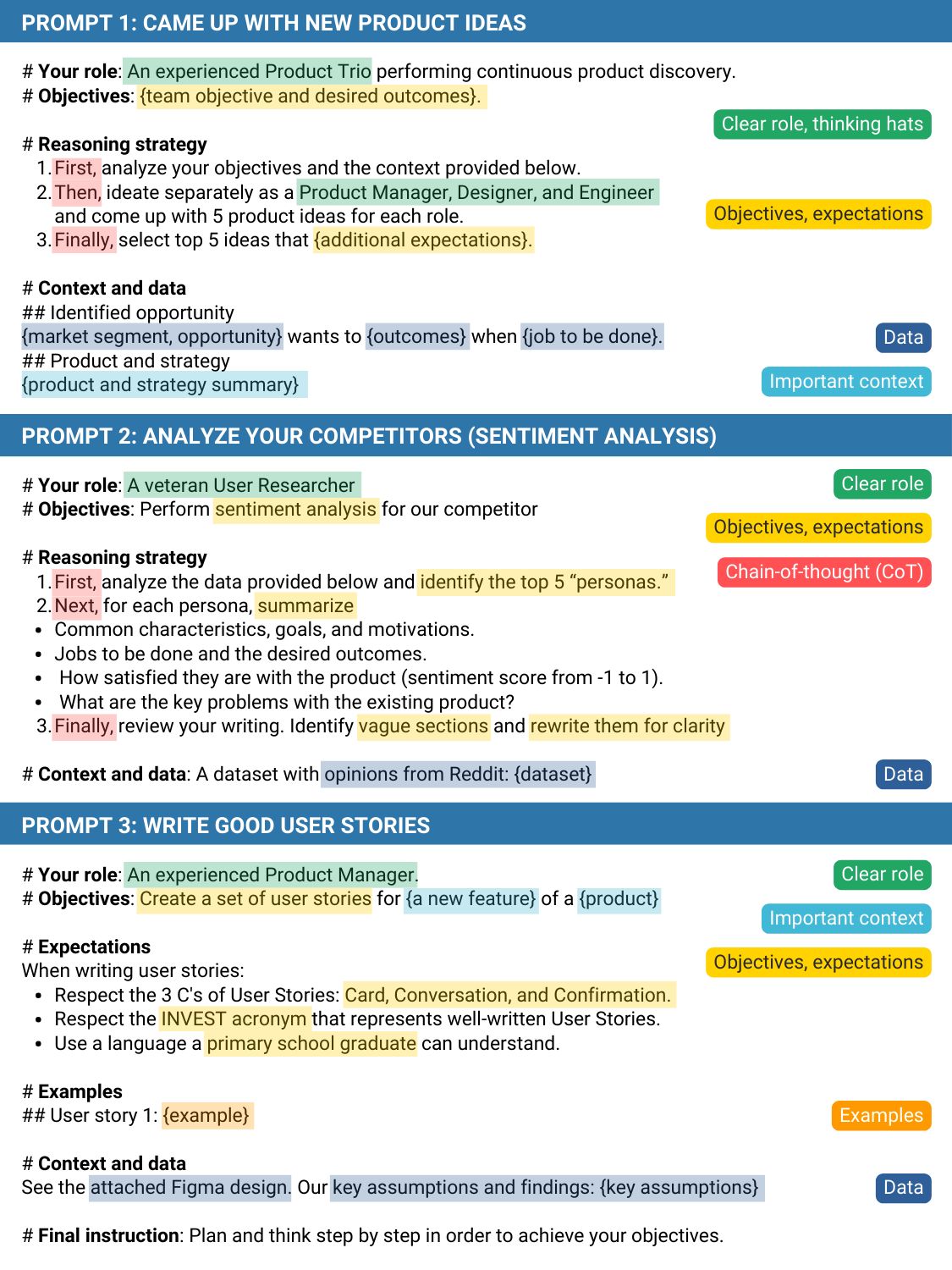
Quick prompting scheme:
1- pass an image to JoyCaption
https://www.pixelsham.com/2024/12/23/joy-caption-alpha-two-free-automatic-caption-of-images/
2- tune the caption with ChatGPT as suggested by Pixaroma:
Craft detailed prompts for Al (image/video) generation, avoiding quotation marks. When I provide a description or image, translate it into a prompt that captures a cinematic, movie-like quality, focusing on elements like scene, style, mood, lighting, and specific visual details. Ensure that the prompt evokes a rich, immersive atmosphere, emphasizing textures, depth, and realism. Always incorporate (static/slow) camera or cinematic movement to enhance the feeling of fluidity and visual storytelling. Keep the wording precise yet descriptive, directly usable, and designed to achieve a high-quality, film-inspired result.
https://www.reddit.com/r/ChatGPT/comments/139mxi3/chatgpt_created_this_guide_to_prompt_engineering/
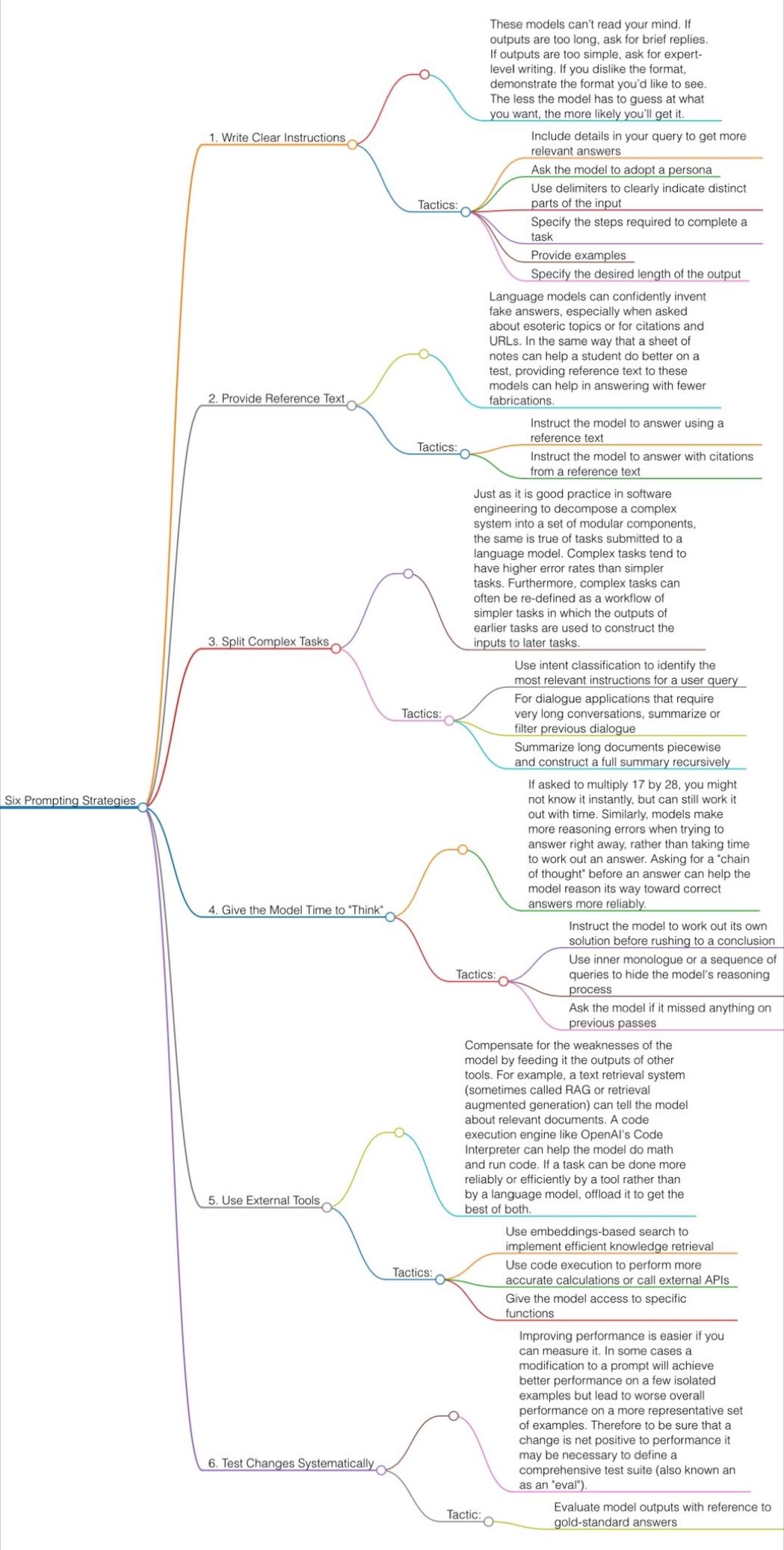

1. Use the 80/20 principle to learn faster
Prompt: “I want to learn about [insert topic]. Identify and share the most important 20% of learnings from this topic that will help me understand 80% of it.”
2. Learn and develop any new skill
Prompt: “I want to learn/get better at [insert desired skill]. I am a complete beginner. Create a 30-day learning plan that will help a beginner like me learn and improve this skill.”
3. Summarize long documents and articles
Prompt: “Summarize the text below and give me a list of bullet points with key insights and the most important facts.” [Insert text]
4. Train ChatGPT to generate prompts for you
Prompt: “You are an AI designed to help [insert profession]. Generate a list of the 10 best prompts for yourself. The prompts should be about [insert topic].”
5. Master any new skill
Prompt: “I have 3 free days a week and 2 months. Design a crash study plan to master [insert desired skill].”
6. Simplify complex information
Prompt: “Break down [insert topic] into smaller, easier-to-understand parts. Use analogies and real-life examples to simplify the concept and make it more relatable.”
More suggestions under the post…
(more…)
-
HDR and Color
https://www.soundandvision.com/content/nits-and-bits-hdr-and-color
In HD we often refer to the range of available colors as a color gamut. Such a color gamut is typically plotted on a two-dimensional diagram, called a CIE chart, as shown in at the top of this blog. Each color is characterized by its x/y coordinates.
Good enough for government work, perhaps. But for HDR, with its higher luminance levels and wider color, the gamut becomes three-dimensional.
For HDR the color gamut therefore becomes a characteristic we now call the color volume. It isn’t easy to show color volume on a two-dimensional medium like the printed page or a computer screen, but one method is shown below. As the luminance becomes higher, the picture eventually turns to white. As it becomes darker, it fades to black. The traditional color gamut shown on the CIE chart is simply a slice through this color volume at a selected luminance level, such as 50%.
Three different color volumes—we still refer to them as color gamuts though their third dimension is important—are currently the most significant. The first is BT.709 (sometimes referred to as Rec.709), the color gamut used for pre-UHD/HDR formats, including standard HD.
The largest is known as BT.2020; it encompasses (roughly) the range of colors visible to the human eye (though ET might find it insufficient!).
Between these two is the color gamut used in digital cinema, known as DCI-P3.
sRGB

D65







